- Introduction
- Simple Statements
- Compound Statements
- Solution to Simple Inequalities
- Multiplication and Division by a Negative Number
- Simultaneous Inequalities
- Graphical Representation of Inequality
- Linear Inequality of Two Unknown
- Past KCSE Questions on the Topic.

Introduction
Inequality symbols
| > | Greater Than |
| ≥ | Greater Than or Equal To |
| < | Less Than |
| ≤ | Less Than or Equal To |
Statements connected by these symbols are called inequalities

Simple Statements
- Simple statements represents only one condition as follows
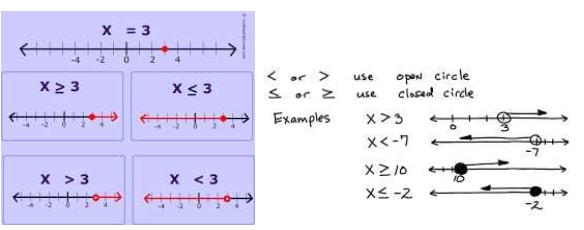
- X = 3 represents specific point which is number 3
- x >3 does not include 3 it represents all numbers to the right of 3 meaning all the numbers greater than 3 as illustrated above.
- x < 3 represents all numbers to left of 3 meaning all the numbers less than 3.
The empty circle means that 3 is not included in the list of numbers to greater or less than 3. - The expression x ≥ 3 or x ≤ 3 means that means that 3 is included in the list and the circle is shaded to show that 3 is included.

Compound Statements
- A compound statement is a two simple inequalities joined by “and” or “or.” Here are two examples.
- 3 ≥ x and x > -3 Combined into one to form −3 < x ≤ 3

All real numbers that are greater than − 3 but less or equal to 3 - x > −6 and x < 3 forms −6 < x < 3

All real numbers that greater than - 6 but less than 3
- 3 ≥ x and x > -3 Combined into one to form −3 < x ≤ 3

Solution to Simple Inequalities
Example
Solve the inequality
x − 1 > 2
Solution
Adding 1 to both sides gives;
x – 1 + 1 > 2 + 1
Therefore, x > 3
Note;
- In any inequality you may add or subtract the same number from both sides.
Example
Solve the inequality.
x + 3 < 8
Solution
Subtracting three from both sides gives
x + 3 – 3 < 8 − 3
x < 5
Example
Solve the inequality
2x + 3 ≤ 5
Subtracting three from both sides gives
2x + 3 – 3 ≤ 5 − 3
2x ≤ 2
Divide both sides by 2 gives 2x/2 ≤ 2/2
x ≤ 1
Example
Solve the inequality 1/3x − 2 ≥ 4
Solution
Adding 2 to both sides
1/3x − 2 + 2 ≥ 4 + 2
1/3x ≥ 6
1/3x × 3 ≥ 6 ×3
x ≥ 18

Multiplication and Division by a Negative Number
- Multiplying or dividing both sides of an inequality by positive number leaves the inequality sign unchanged
- Multiplying or dividing both sides of an inequality by negative number reverses the sense of the inequality sign.
Example
Solve the inequality 1 − 3x < 4
Solution
−3x – 1 < 4 – 1
−3x < 3
−3x > 3
−3 −3
Note that the sign is reversed x > −1

Simultaneous Inequalities
Example
Solve the following
3x − 1 > −4
2x +1 ≤ 7
Solution
Solving the first inequality
3x – 1 > −4
3x > −3
x > −1
Solving the second inequality
2x + 1 ≤ 7
2x ≤ 6 Therefore x ≤ 3 The combined inequality is −1 < x ≤ 3

Graphical Representation of Inequality
- Consider the following;
x ≤ 3
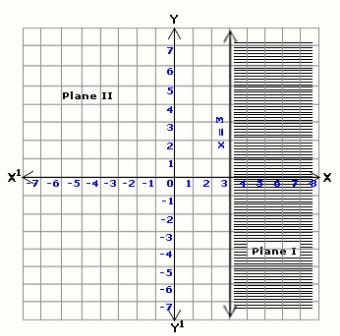
- The line x = 3 satisfy the inequality ≤ 3, the points on the left of the line satisfy the inequality.
- We don’t need the points to the right hence we shade it
Note: - We shade the unwanted region
- The line is continues because it forms part of the region e.g it starts at 3.for ≤ or ≥ inequalities the line must be continuous
- For < or > the line is not continous, its dotted.This is because the value on the line does not satisfy the inequality.
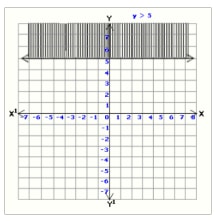
Linear Inequality of Two Unknown
- Consider the inequality y ≤ 3x + 2 the boundary line is y = 3x + 2
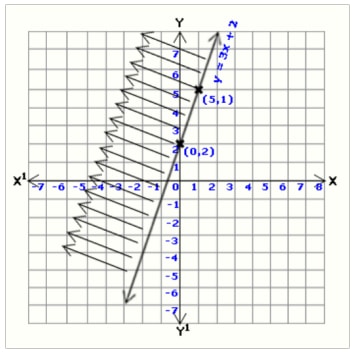
- If we pick any point above the line eg (-3, 3 ) then substitute in the equation y – 3x≤ 2 we get 12 ≤ 2 which is not true so the values lies in the unwanted region hence we shade that region .
Intersecting Regions
- These are identities regions which satisfy more than one inequality simultaneously.
Example
Draw a region which satisfy the following inequalities y + x ≥ 1 and y − 1/2x ≥ 2
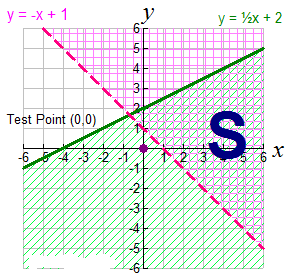

Past KCSE Questions on the Topic.
- Find the range of x if 2 ≤ 3 − x < 5
- Find all the integral values of x which satisfy the inequalities:
2(2−x) < 4x − 9 < x + 11 - Solve the inequality and show the solution
3 – 2x < x ≤ 2x + 5 on the number line
3 - Solve the inequality x − 3 + x − 5 ≤ 4x + 6 − 1
4 6 8 - Solve and write down all the integral values satisfying the inequality.
x – 9 ≤ − 4 < 3x – 4 - Show on a number line the range of all integral values of x which satisfy the following pair of inequalities:
3 − x ≤ 1 − ½ x
−½ (x−5) ≤ 7−x - Solve the inequalities 4x – 3 6x – 1 3x + 8; hence represent your solution on a number line
- Find all the integral values of x which satisfy the inequalities
2(2 − x) < 4x -9< x + 1 1 - Given that x + y = 8 and x²+ y²=34
Find the value of:-- x²+2xy+y²
- 2xy
- Find the inequalities satisfied by the region labelled R

- The region R is defined by x ≥0, y≥ −2, 2y + x ≤2. By drawing suitable straight line on a sketch, show and label the region R
- Find all the integral values of x which satisfy the inequality
3(1 + x) < 5x – 11 < x + 45 - The vertices of the unshaded region in the figure below are O(0, 0) , B(8, 8) and A (8, 0). Write down the inequalities which satisfy the unshaded region

- Write down the inequalities that satisfy the given region simultaneously. (3mks)
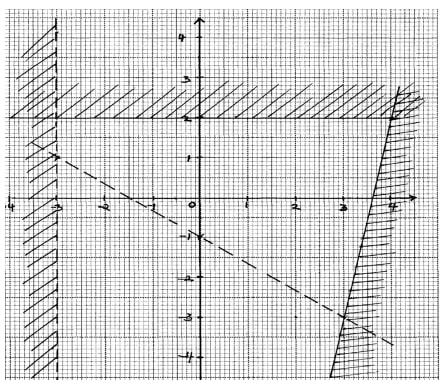
- Write down the inequalities that define the unshaded region marked R in the figure below. (3mks)
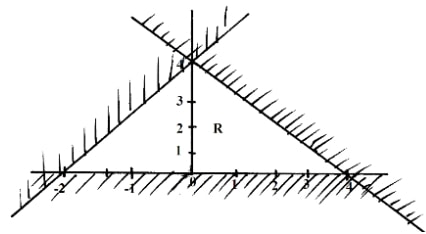
- Write down all the inequalities represented by the regions R. (3mks)
- On the grid provided draw the graph of y = 4 + 3x – x2 for the integral values of x in the interval −2 ≤x ≥5. Use a scale of 2cm to represent 1 unit on the x – axis and 1 cm to represent 1 unit on the y – axis. (6mks)
- State the turning point of the graph. (1 mk)
- Use your graph to solve.
- −x2 + 3x + 4 = 0
- 4x = x2
Download Linear Inequalities - Mathematics Form 2 Notes.
Tap Here to Download for 50/-
Get on WhatsApp for 50/-
Why download?
- ✔ To read offline at any time.
- ✔ To Print at your convenience
- ✔ Share Easily with Friends / Students


